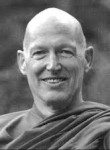Sakkaya ditthi, the wrong view of self, is the first of the ten fetters that bind unenlightened beings. Its counterpart or antidote is Right View or Right Understanding, the first fold of the Eightfold Path.
Until we arrive at samma ditthi, the correct view of self, it’s hard to loosen the other nine fetters.
Who practices Zen? A deluded thing that calls itself “me.”
“I must practice Zen so that I can become enlightened some day” is a thought generated by the wrong view of self. “Even if I never attain enlightenment, I will do these practices and become a better person” is another thought generated by the wrong view of self. Both statements presuppose a self that can be improved but there is no separate self and Buddha Nature cannot be improved.
The belief that we own a self that is permanent and pleasurable is a view held by unenlightened sentient beings.
We are convinced that every thought we have is our thought, everything we see is what we see. We identify our subjective thoughts as being us. It never occurs to us that our subjective thoughts are just mind objects like the Statue of Liberty, Mount Everest, and all of the other stuff that we perceive as not-us, not-self, anatta.
We wake up when we understand that everything we think is us, isn’t.
The Shurangama Sutra teaches that it is Seeing Awareness that sees, not “me.” It is Hearing Awareness that hears, not “me.” It is Thinking Awareness that thinks and “my” thinking is just meaningless elaboration.
Awareness is not an entity, a sentient being. As Ajahn Sumedho, pictured above, points out, our idea of “self” arises within Awareness, not the other way around, i.e., it is not the self that is aware. Awareness is aware and the self is a mind object.
Buddha Nature, Universal Consciousness, the Deathless, Awareness, whatever it may be called, is not a sentient being or an entity (and to give it a name, any name, is to miss it). The point of Zen practice is to awaken, to become aware. Buddha Nature is not something “out there.” There is no “in here” so that can’t be an “out there.”
The Buddha taught that we overcome sakkaya ditthi through samatha (calmness meditation as taught in the Anapanasati Sutta), vipassana (insight meditation) or bhavana (a combination of both).
Zen teachers teach essentially the same thing but with a few “modern” techniques such as koan and shikantaza practice. Koans and shikantaza were apparently unknown to the Buddha because those practices are not mentioned in the Pali canon.
But in the ninth step of howtopracticezen.com, we learn that the super power mindfulness generated by the meditation the Buddha taught can be harnessed to solve koans.
And when our koans are solved, sakkaya ditthi becomes samma ditthi. As the student, the subject, struggles with the koan, the object, the separation between the two disappears.
Ajahn Sumedho, pictured above, explains sakkaya ditthi much better than I can. Many of the informal talks collected in The Sound of Silence include his understanding of sakkaya ditti. One of the talks included in the book, entitled The Problem of Personality, is worth reading and re-reading. A shorter book with fewer talks but which also includes The Problem of Personality, is available for free at http://www.amaravati.org. If you take the free book, a contribution to the monastery is in order. A free version of The Problem of Personality is also easily found on the Internet by any search engine.
Ajahn Sumedho also discloses a particular technique that we can use to develop Awareness. It helps us to see that Awareness is there before a thought arises, and after the thought has ended. So the point of practice is to become aware of the Awareness that was there all along, covered up by sakkaya ditthi.

